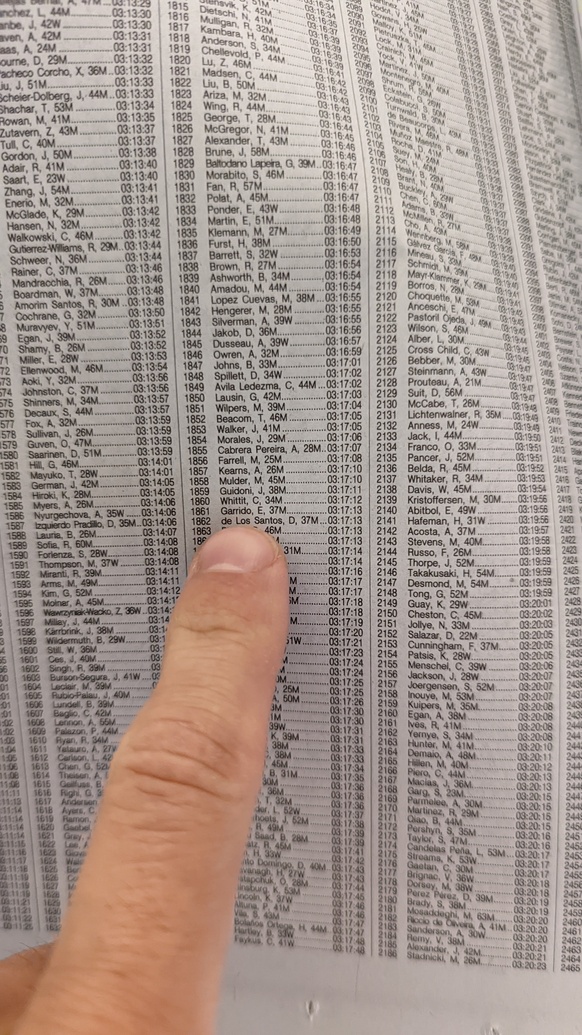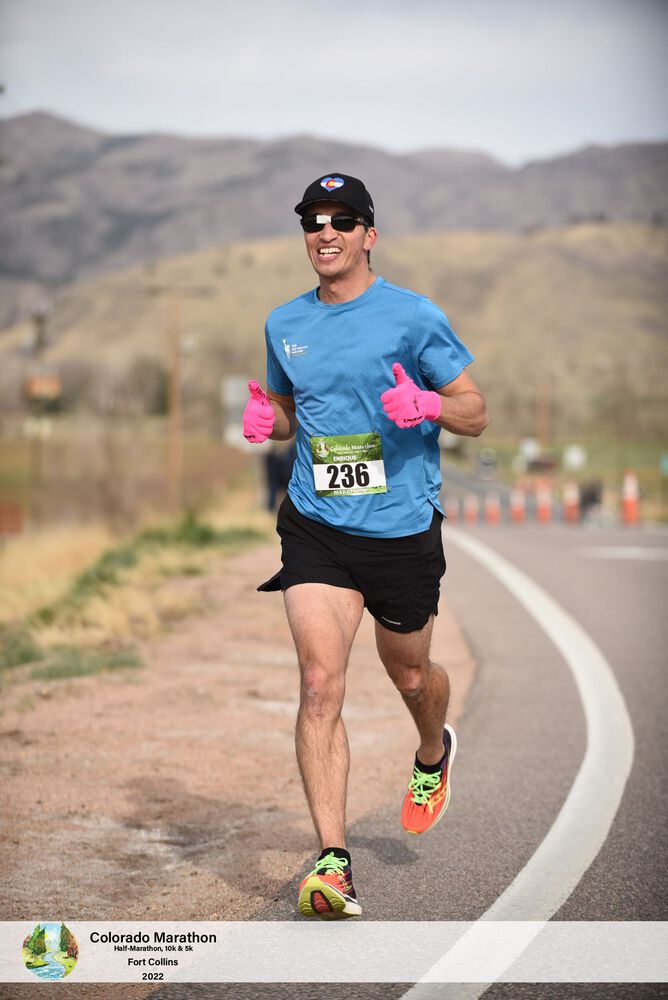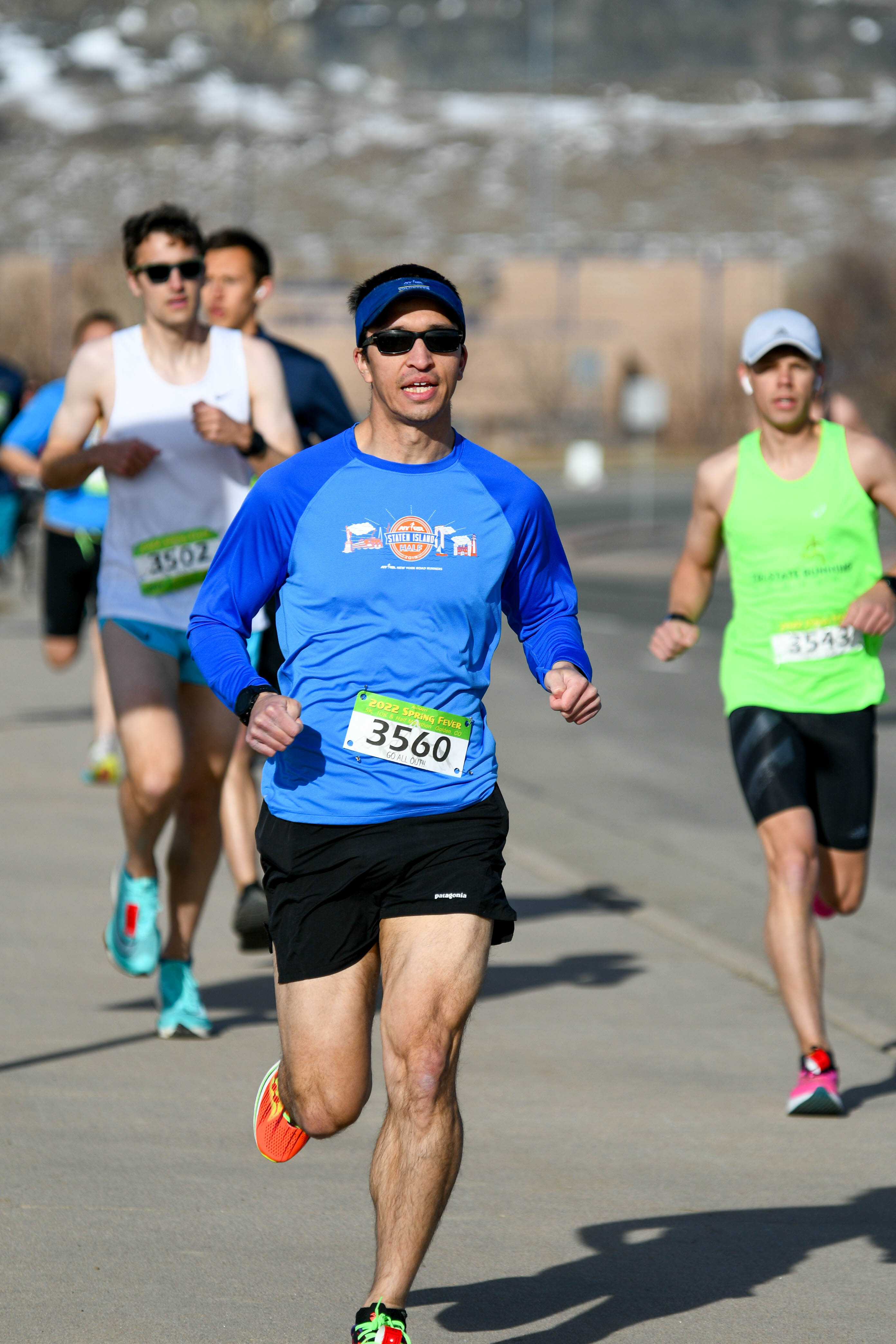I ran the New York City Marathon on November 6, 2022. These are my notes on race preparation and execution (as usual, mostly written to remind myself about the experience in decades to come).
Result
3:17:13. 1,861/47,745, 344/3,769 AG
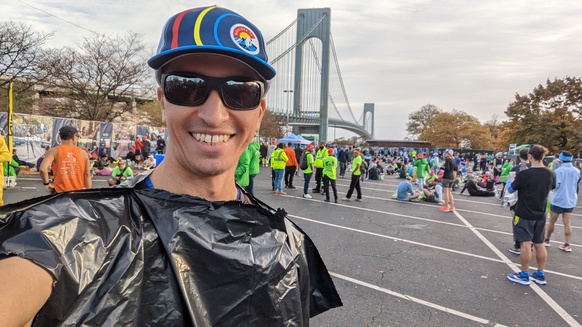
Goals
✓ Goal A: Finish
✗ Goal B: Sub 3:14:16 (== π, my previous NYC result in 2019)
✗ Goal C: Sub three hours
✗ Goal D: Sub 3:05 (BQ cutoff for my age group)
My goals were inverted for two reasons:
-
I suffered a knee injury during training, resulting in three weeks almost completely away from running toward the end of the training cycle. Making it to the start line was not certain and finishing at all would be a gift from the gods.
-
The conditions for the race were less than ideal: 70°F/21°C at the start and 75°F/24°C by the time I crossed the finish line, mostly sunny, with humidity above 80% at the start.
Training
Coming off of my skin-of-the-teeth-sub-3 hour run in the Colorado Marathon, I knew my goal would be to best that time. I also knew that NYC is a hard marathon course and there’d be no net-downhill elevation loss to help, though almost two years of altitude training would help in this race at sea level.
The first thing to optimize for improving endurance pace for someone like me is weekly training mileage. For the weeks leading up to the Colorado Marathon, I had been running between 36 miles (58 km) and 56 miles (90 km). By most accounts, this is too low for most people to achieve a consistent sub-3 hour marathon.
I think any plan with increased mileage would have been more than adequate. I decided to use Pete Pfitzinger’s 18 week-long plan for 55-70 miles (89-113 km) per week (affectionately known as Pfitz 18/70). I enjoyed reading the accompanying book and the mileage was a step up from what I was used to. The written plan was easy to understand, though I admittedly missed having a calendar and workouts synced to my watch as I had in the McMillan plans I had been using.
Pfitz 18/70 is very endurance-heavy. The focus is on increasing mileage through successively longer mid-week runs (so-called “medium-long runs”) and Sunday runs (the standard long-run). The medium-long runs, maxing out at 16 miles (26 km), quickly became longer than my previous long runs had been, which were usually around a half marathon. I never thought I’d be running 14 or 16 miles on random Wednesday mornings and having a longer run later in the week!
I did find it a little stressful to have to schedule the weeks with longer distances, having a toddler in daycare and a job with my team based in NYC and its timezone. I got accustomed to pre-dawn alarms and starting runs at twilight or getting in non-key workouts on the treadmill at work after my team left the office. I’d occasionally use the treadmill in my apartment building after my daughter’s bedtime, but I don’t do great with late-night exercise, especially when having to get up early the next morning to run more. I’m not sure that I’d be able to run more mileage sustainably; my wife might start to get mad and I might start to burn out.
Because of those constraints, I ended up only hitting a maximum of 67.25mi (108 km) instead of the planned 70mi (113 km). But, I was pretty consistent week-in and week-out in hitting all of the planned workouts. Overall, my plan to increase mileage worked and I saw clear benefits, as expected: running longer distances became significantly less daunting and running at the same pace became easier.
One highlight of the training cycle was when my wife was going out of town for a weekend, so I knew I’d have to skip a couple of runs, including a long-run. I decided to embark on a slightly more epic run than usual before she left: do my scheduled 20 mile long run, but run up one of the local mountain roads, ultimately netting 2,835 feet (864 meters) of vertical, with a great view at the top. It was here that I realized I suck at running up 10-15% grade hills and that I remembered how hard it is on one’s knees and quads running downhill. I was good and sore for days.
As I could have predicted with the difficulties in just scheduling the running portion of the plan, I skimped out on pre-hab (i.e. stretching before and after workouts) and weight training. I had hoped that I’d be able to move into our house during this training period and make use of our basement gym, but the renovation took significantly longer than we anticipated. I had alternate means to pick up heavy things and put them back down, but I failed to employ them.
The increase in mileage, increase in training pace, and severe lack of cross training set me up for injury. I knew this was a risk the longer I put off weight training, but I decided to play the cards. I lost the bet and ended up with a case of either runner’s knee or bursitis. I remember distinctly the moment my knee suddenly started emanating debilitating pain: waiting to cross the street toward the end of a medium-long run. I ran through it for a few days (even completing a 22 mile long-run that weekend) before deciding to take what eventually was almost three weeks completely off from running.
This meant that I ended up needing to skip the most interesting part of the plan: the integration of VO2Max sessions for improving speed.
Taking time off was fine: I knew that I’d have to do it in order to get to the starting line in New York. I knew that I’d lose some fitness, but that I’d still have about a month to claw back whatever I could, and I’d be more than happy to even put in an effort similar to the Colorado Marathon and no more.
I did have a fear of reinjuring the knee after coming back off the couch. It felt mostly pain free even in the first few runs back, but I knew that reinjury meant no NYC Marathon. I reduced the pace of my runs a bit and didn’t do the prescribed VO2Max sessions.
Race Week
The week before the NYC Marathon is a real special time. With tens of thousands of visitors to the city and numerous pre-race events planned, there is a palpable sense of energy and excitement in the air. As the finish line is constructed by Tavern on the Green, Central Park becomes a place to see and be seen, with large groups running together in team kits, and professionals getting in their last workouts.
The weekend before the race, I had to attend my cousin’s wedding in Maryland. I was a little disappointed by the travel timing here, since it meant I would sacrifice over a week of altitude benefits.
I decided to work in the office on Thursday and Friday, but I also joined some group shakeout runs put on by a major running store near the park and near where I was staying.
Finding out about these events is a little hap-hazard. Some are on the official NYRR marathon calendar, but a lot of brands have special events that don’t get advertised very well. I heard of most of the goings-on from Mario Fraioli’s Morning Shakeout newsletter and from Kofuzi’s YouTube channel. I only heard of Eliud Kipchoge’s appearance at the Nike shakeout run after the fact.
I reread “A Race Like No Other” by Liz Robbins and got hyped up again.
I missed out on a critical marathon post-registration email and had only one option for transportation to the start line: the Staten Island Ferry. So, when my wife left to go back to our daughter and her grandparents in New Jersey, I moved from a cute boutique hotel to the Hilton Garden Inn near the Staten Island Ferry terminal so as to minimize travel time between waking up and getting on the boat. Though the hotel was quite far removed from any desirable area of the city, including all of the other marathon events, this worked out really well and significantly reduced pre-race stress.
I met up with some crazy Spaniards to run another shakeout run. I later met up with my awesome New York-based friends at a local brewery, which may not have been the best idea for performance, but was definitely fun.
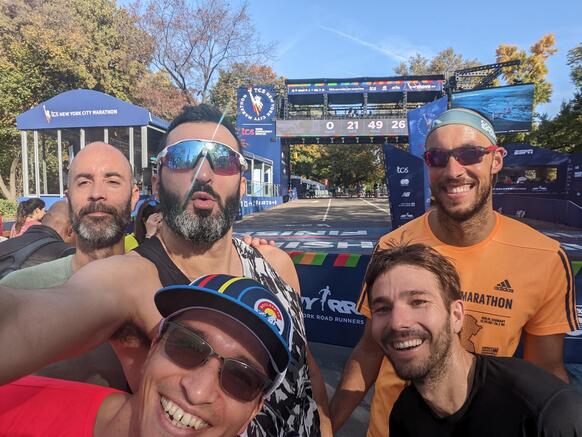
I laid out my clothes for the next day, filled my pockets with gels, made my PB&J sandwiches and went to sleep early. For once, I was actually able to sleep a decent amount before a race.
On the ferry to Staten Island, I sat next to David Laurance, a local celebrity for having run the second most NYC Marathons in a row: 44 by age 70.
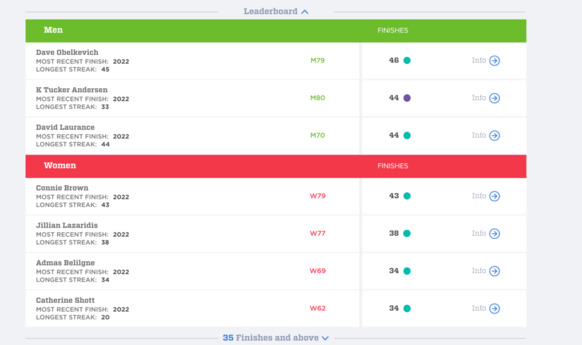
Race
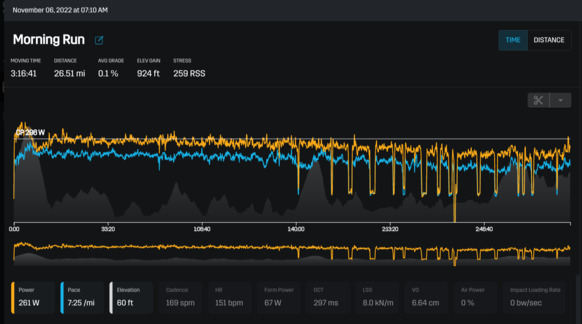
The weather turned out to be a bigger consideration than I had expected, especially since I lost a bunch of heat acclimation, having avoided running for most of the month of September. 70°F/21°C at the start and 75°F/24°C by the time I crossed the finish line, mostly sunny, with humidity above 80% at the start.
Still, the start went great. I wanted to catch up to the 3 hour pacers a couple of corrals ahead of mine, but I didn’t have to jostle much going up the bridge to get to them. That said, I definitely should not have lit a match so early in the race to get to them so soon.
The first 14.7 miles (23.7 km) were buttery smooth. I was right on my pace target and it felt pretty effortless. I forced myself to stop at every Gatorade station knowing I was losing a ton of water to the weather. Me and everyone around me were just totally drenched in sweat, head to toe, because the sweat had nowhere to go with the high humidity.
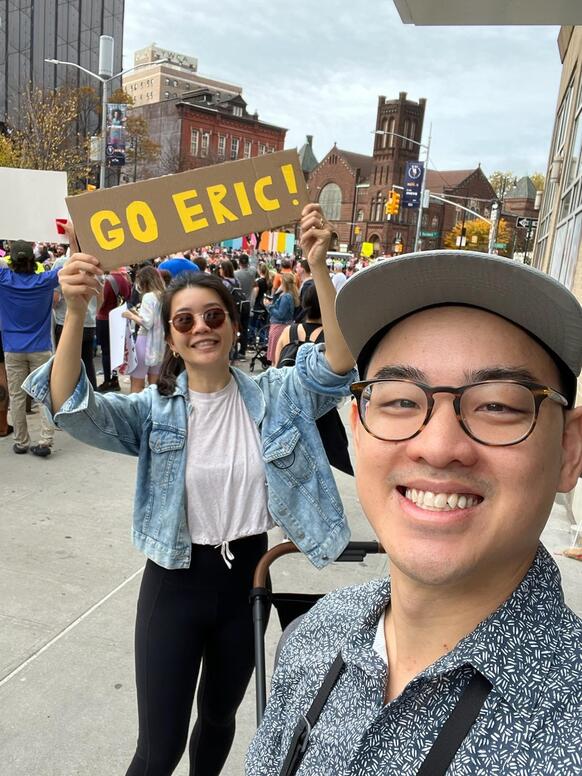
But then my right foot started to hurt. And hurt more. And hurt even more. It felt like I was getting stabbed every time I landed on it. It felt very constricted within my shoe; I stopped to loosen the laces, but to no relief.
The rest of the race was really a run/walk. I walked through all of the aid stations and then some. Where my first 14.7 miles were at an average of 6:43/mi (4:10/km) pace, my last 12 were at 8:18/mi (5:09/km).
In the last 10 miles (16 km), I’ve never seen so much human carnage. There were people just lying on the side of the road, some conscious, some unconscious. Walkers were everywhere at the edge of the course. In the 25th mile, I even saw a runner crawling toward the finish line.
Turning into Central Park off of the 5th Avenue climb was such a mental relief. I knew the finish line was just on the other side of the park. But I knew there would still be some challenging terrain ahead of the uphill finish. I hobbled through the park, with mile 24 being my worst mile split at 9:01/mi (5:36/km).
I crossed the finish line and hobbled down the long, silent stretch of Central Park Drive toward the exit of the park. The scene looked like a zombie apocalypse, worse than 2019: everyone was shuffling along, hurt and/or dehydrated, and sore.
The conditions made this a really tough race. In 2019, I placed 3,187/53,520 with a 3:14:16. In 2022, I placed 1,860/47,745 with a 3:17:13. So, despite a three minute worse time, I nearly halved my placing, indicating the entire field slid backwards. I know of strong 2:40 marathoners with a worse time than mine. It was brutal and I’m glad I made it to the finish line.
I was also happy to have beat Ashton Kutcher’s time of 3:54:01.
Post-Race
I took the subway back to my hotel, showered, packed, and headed right back out to catch the next train to New Jersey to see my daughter and my wife.
I think the race was summed up nicely on a post on /r/runnyc entitled “That was fucking awful” with no body. Casey Neistat’s amazing video entitled “i got beat up at the NYC Marathon 2022” was also quite apt.
It was only later that I learned that the bus situation on Staten Island deteriorated worse than when I was there in Wave 1. Then, later waves had to not only battle through a hotter part of the day, but also suffered from running out of cups for Gatorade and water.
I also saw Daniel Do Nascimento’s amazing performance… through mile 21. It turns out that anyone can run fast in a marathon, in the heat, as long as they don’t expect to finish. I can’t wait to see what he does with a bit more restraint.
We flew back to Colorado the next day and I was planning to take the entire month of November off from work in order to celebrate running the marathon and getting through the pandemic. That happened, but started in a different way than expected: I promptly got a positive COVID test and had to sequester myself away from my wife and daughter.
